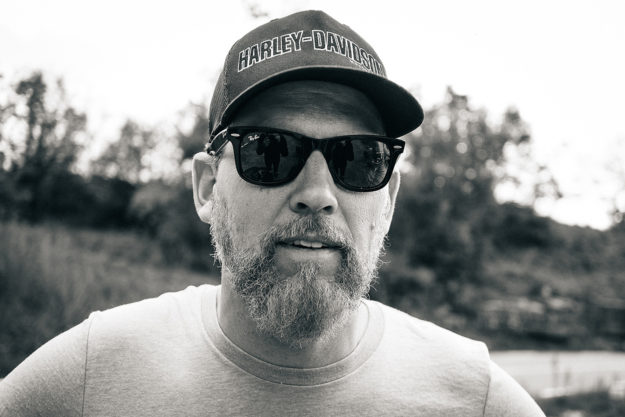
Harley-Davidson is under a microscope right now: its every move is dissected, examined and critiqued.
And there have been plenty of moves lately. They’ve killed the Dyna while relaunching the Softail. They’ve announced a barrage of new models, including the Livewire. But although revenue is holding up at the moment, sales figures have been declining for several years—and were down 10% in 2018.
It’s a challenging time for the Motor Company. So I sat down in Milwaukee with Harley’s VP of Styling and Design, Brad Richards, to ask how they’re going to fix this. Harley’s PR lead Joe Gustafson joined us too, and both were raring to go.
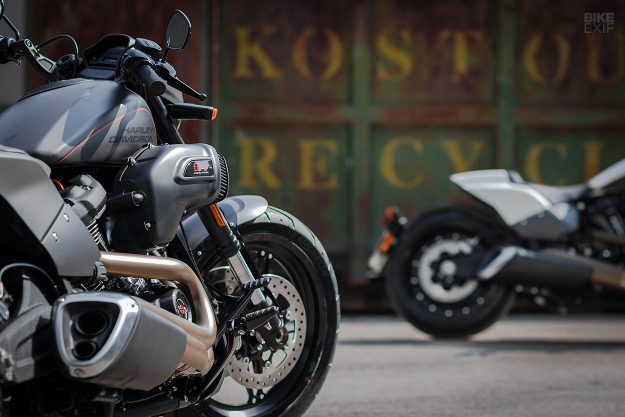
Bike EXIF: There’s a lot of pressure on Harley-Davidson right now. People expect every new bike the company releases to be ‘the’ bike to turn things around.
Brad: It’s so funny that you should say that. It’s as if you’re the Rolling Stones or the Beatles, and your entire library was forgotten before whatever single you’re putting out. That’s what you’re judged on—the latest track.
You really think that we’re just going to abandon the core, and start doing other things? The messaging has always been that we’re going to embrace electric … because it breaks down so many barriers for new riders. There’s no transmission, there’s no clutch. It’s very simple to get involved in two wheels, via electric.
But we’re also going to innovate with our core internal combustion product as well. The only reason that I think folks are letting us get away with the electric stuff—and not everybody is accepting of it, but most people are—is because we haven’t abandoned our core product. If you think about Pan America and the Streetfighter and so on, those are bikes in the middleweight space, and we’re clearly innovating and investing in the future of that product.
So when I hear people saying ‘Oh, Harley’s lost their way, they’re making an electric bike, it’s all over…’ you’re exactly right, they’re only looking at the electric product. I feel like they need to look at the rest of the portfolio too.
Right after announcing ‘More Roads,’ you released the FXDR 114. Detractors were saying that it’s too traditional a Harley and won’t attract new riders. And some older Harley fans didn’t quite get the modern styling. How do you manage that tension between the brand’s history, while still looking forward from a design point of view?
Brad: I think it’s a great question. If you look back at the history of Harley-Davidson—from the birth of the company—we were incredibly innovative. People say we’ve never done an adventure touring bike—in 1903, roads were not paved. Every bike we made was an adventure touring bike.

During World War II we made a hundred thousand WLAs; that was a bike that was also intended for pure off-road use. You can argue that World War II kind of created the birth of the segment, and we were there with a product. There are still thousands of them running around today, still functioning.
So when people have a hang up on what we’ve just released. Most of the time it’s because the context in which they’re making that judgment, is the last 20 years. The boom years, the core, mid-90s through early 2000s, where our current archetype rider was defined.
The new generation wants nothing to do with that archetype—loud and proud and bold. We love those folks, and I love that part of the culture. But millennials don’t want that. They want subtlety, they want high quality experience, but they don’t brag, they don’t boast, they’re not loud, they’re not obnoxious. So we have to be able to tailor some of the products to this new generation.
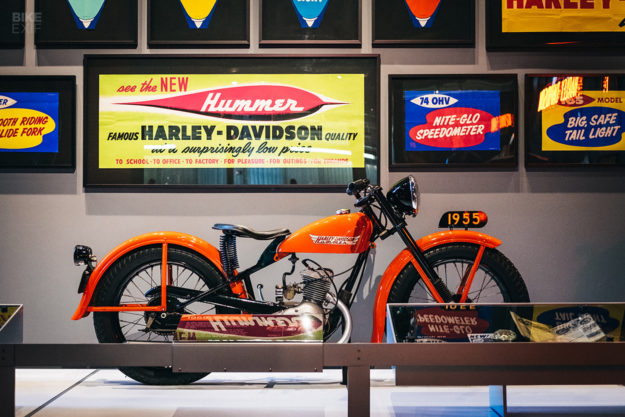
It’s the same problem that we had in about 1947. Post World War II there was a massive boom. Guys came back from the military, and there was this huge investment in social free time and hobbies and so on, and our bike sales went through the roof. But by 1949, there was a massive drop-off in the sales of our big twins. The volumes were almost cut in half. And so we invested in light weight and low displacement. That’s how Sportster was eventually born.
We’re going through the same thing right now. It’s so cyclical. So it’s funny to me.
We’ve done tons of research. And the research has told us that the younger generation loves the brand. They know what it stands for, they know its authenticity and quality and the history, but they just don’t see products that they really wanna ride. So the More Roads initiative is to create bikes that appeal to that generation, because they’re giving us the permission to go into adventure touring, to go into electric, to go into Streetfighter, and other places that we’re gonna go.
It’s the tip of the iceberg. The next five years, we’re gonna blow minds. I keep thinking about the reaction we’re getting now, it’s like ‘holy smokes, wait two years from now,’ because the stuff is just gonna keep coming.
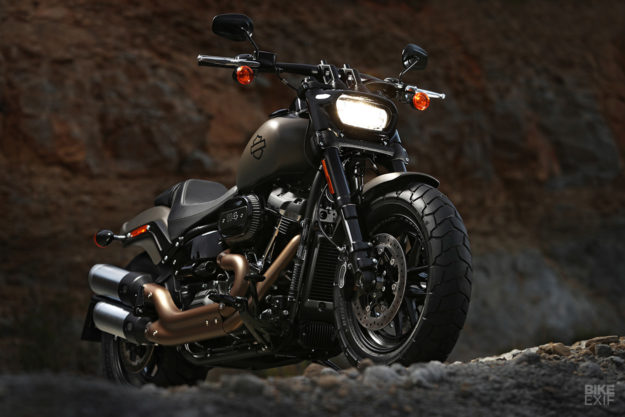
When the new Softails were released, a lot of people were upset that the Dyna was gone. But when the Dyna was first released, no one liked it. So I guess by now you’re used to weathering that storm of criticism…
Brad: You have to have a thick skin. Some of the younger guys in the studio who are right outta school, they design something, and all of a sudden the feedback starts coming out on Instagram. They’re like ‘Holy smokes!’ It’s okay…most of the folks that you meet love what we’re doing and understand what we’re doing.
When Pan America [below] was revealed, and the feedback started coming in, it was pretty polarizing. There was some great stuff and there was some pretty bad stuff, and what I told upper leadership at that time, was, the worst thing that we could have done is release a design and no-one commented on it.
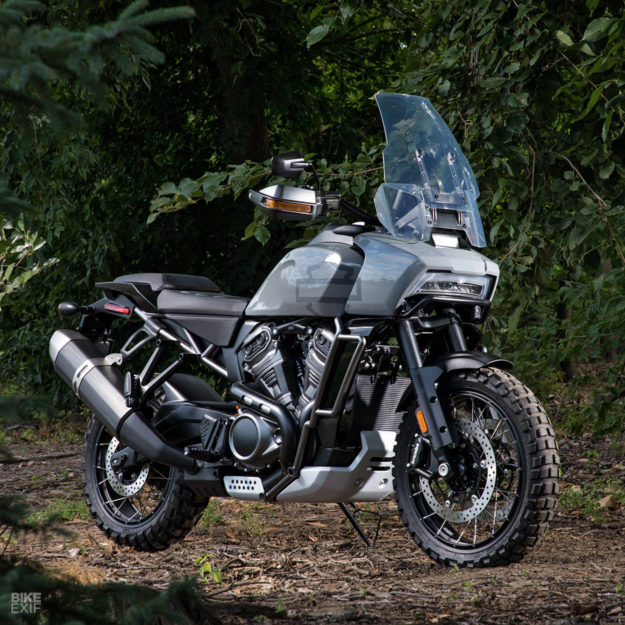
I personally love all the feedback, whether it’s good or bad, and I love people that bring it to me and are very frank, and ask me why we’re doing what we’re doing. As a designer, I wanna do things that are compelling, that are remembered. Our team wants that.
And are we gonna have home runs every bike? No. That’s impossible. But we’re gonna have some really compelling product, that in the future will be in the museum, and people are gonna say ‘You know what? That’s the moment when they pivoted, and thank God they did, because they’re still in business today.’
Joe: You look at Softail, and you look at what was added to the conversation. You look at Dyna, and people like performance, they want the feel, they want the look. And Softail’s lighter, it’s smoother, and it’s faster.
Yeah it’s better, in every way.
Brad: I have a Low Rider S, that’s my favorite bike [below]. And that was the first bike that I did when I got here with the team. We had a hole in the life cycle plan, and we needed something quickly, just to be totally frank, and all the parts and components were there. And we all knew what was happening with Dyna.
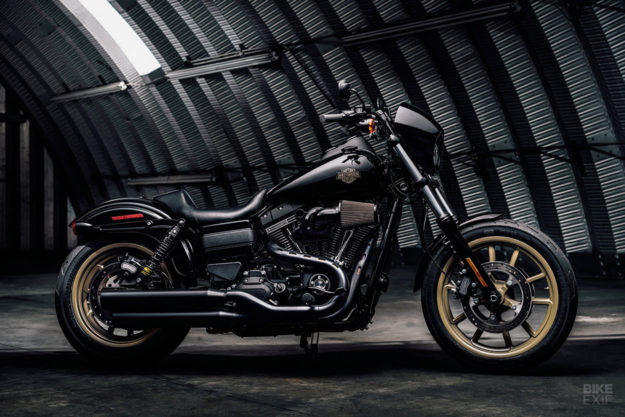
So was that your ‘twilight’ Dyna?
Brad: Yeah, we wanted to make the ultimate Dyna. That’s why I’ll never sell mine, I think it’s gonna be a collector’s item. But having said that, and as much as I love my bike—and I put money into it, upping the performance and suspension and doing all kinds of things to it like everybody does—when I went to Spain and rode with you guys on the new bikes, there’s no comparison.
The new Softails are just infinitely better motorcycles. And if you talk to anybody who really does this stuff and takes it seriously—Mark Atkins [Rusty Butcher], Speed Merchant, Noise Cycles—the guys who are riding our new bikes, taking them apart and customizing ’em. They all know that the new bikes are infinitely better too.
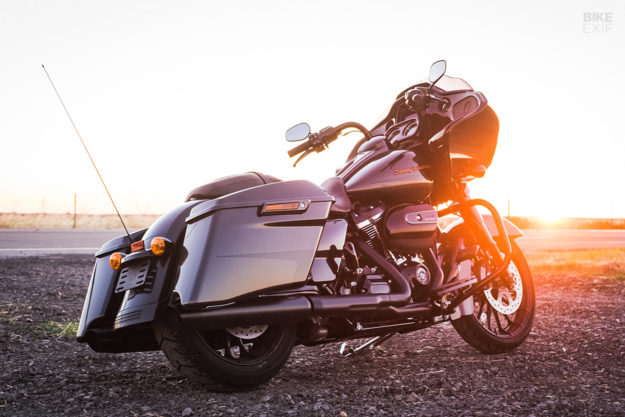
Are you feeling a lot of pressure to progress on the tech front? Premium bikes like the FXDR 114 and Road Glide [above], for example, don’t have some of the same tech (like switchable rider modes) that their competitors do.
Brad: We look at everything. I wish I could take you to the test track in Yucca, Arizona, and show you all the things that we’re experimenting with.
We are not static any more. We are embracing these things, and we are exploring all avenues of technology, and motorcycling. Because all of these things that you’ve described, make motorcycling safer, and easier, and it breaks down barriers for people to get into the sport.
Joe: If you look at Livewire [below], it’s got riding modes, it has a six-axis IMU, it has cellular connectivity. I could be sitting at lunch and know when my bike’s being charged.
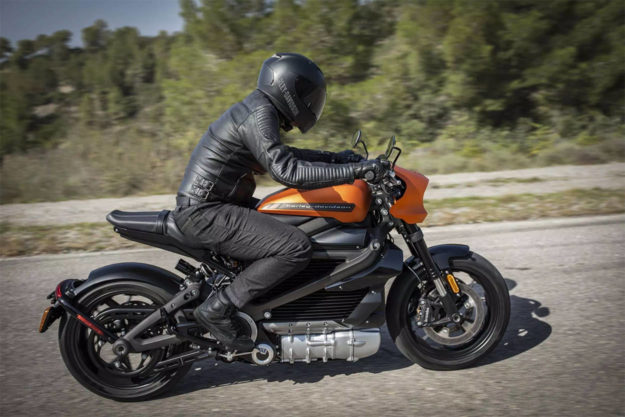
But that tech (in Livewire) comes at a massive premium.
Brad: Livewire’s a halo product. It’s a halo product for EV, but it’s also a halo product for connectivity and all these other things that Joe just described. These things eventually become less expensive, and we do integrate them into the rest of the product line.
But let’s be frank. It is not a bike that’s been designed for millennials, from a price point. And the EV technology’s expensive right now. Battery technology’s incredibly expensive. It will get less expensive, and it’s going to change, but Livewire’s really about the first product from a major OE, that’s very compelling, very well engineered.
I think that there was a misconception, in the way it went to market for some reason—it didn’t really come from us—that it is the answer to the millennials.
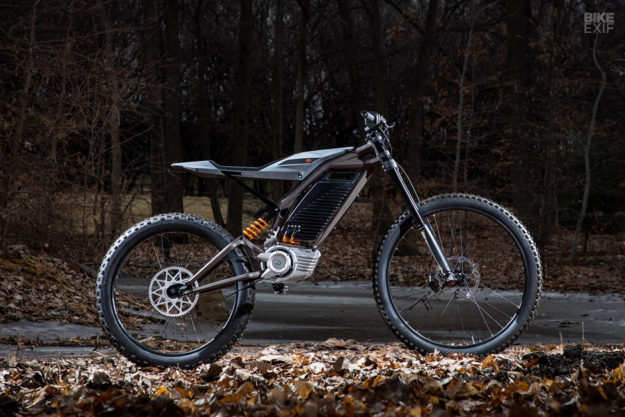
From a design point of view, Livewire does hit that sweet spot between modern, and keeping with Harley-Davidson’s design language. But how did you figure out the smaller electric vehicles, from a design point of view?
Brad: We had the one that’s in between a dirt bike and a mountain bike—the one that was at X Games [above]. But we felt in the studio that there might be something that was more like a 70s minibike [below]. Because a lot of us that ride Harleys, grew up on a little Briggs and Stratton minibike.
So it was like: “What if we took this, and did the modern interpretation of that?’ And all of a sudden you have this whole new generation of younger folks, learning to ride a Harley-Davidson on something like that.
A lot of the baby boomers, and what we call our core customers, are sort of ageing out of the sport. They’re embracing things like boating and RV-ing and camping. And really, that is a migration stream that’s happening. So I said, “What a great way for that generation to reconnect with Harley-Davidson, by having a couple of these strapped to their Airstream trailers.”
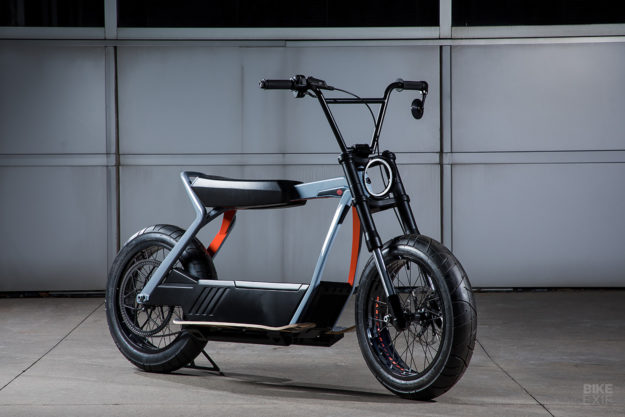
We wanted to do something that was very friendly, very approachable. But the trick is, that when you get on it, it’s gotta be fast as f–k. We called it the ‘Angry Little Bastard,’ that was its nickname. So you have this little thing that looks like a kid’s scooter, you get on it, and it’ll outrun a Sportster ’til 3rd gear.
Joe: From a riding situation—no license, torque, speed—it pulls so many notes of what people love about motorcycles into a new package. That’s really what it’s all about. We were at X Games with these concepts, people that didn’t even ride…it kind of pulls at those heartstrings. ‘What is this? I love Harley, I want this.’
I guess online commentary always leans towards being more negative than positive… was the reaction different when people saw the bikes in person?
Joe: Oh absolutely. Think about on Bike EXIF with the seat argument. ‘You can’t sit on that seat, there’s no way that’s gonna be fun!’ Then you see it in person. I would challenge a lot of Bike EXIF commentators to say if they saw that bike in person, they would love it.
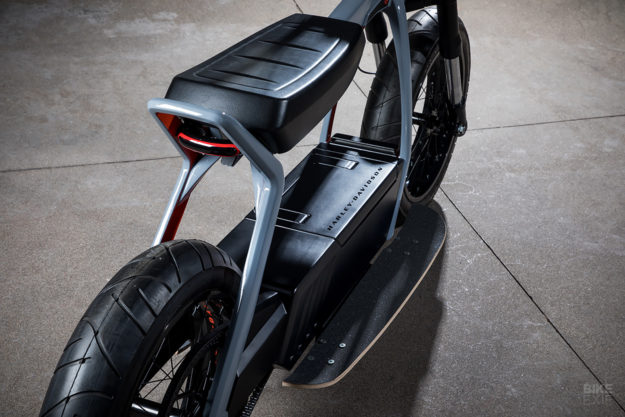
There’s a lot of riding scenarios, that you gotta look at those two concepts where it’s not, you know, “I’m gonna buy this bike and I’m gonna go to Sturgis.” It’s: “I’m gonna buy this bike, and fit it in my life.” Which is a really cool aspect of these bikes.
Brad: It was all about getting people to embrace two wheels, because that wasn’t happening with the current state of product that’s out there.
I love the smaller electric concepts, but personally I think Livewire’s too expensive for everybody.
Joe: If you look at the package of that product—it’s performance, it’s the riding suite, it’s connectivity. So it’s not price point. It’s, “What experience are you trying to get for that?”
Brad: I’d argue that there are some customers who have never looked at Harley-Davidson, because there hasn’t been an EV product. If you read some of the feedback, it’s “never been interested in Harley-Davidson, never noticed the brand, until they agreed to do this. Until they showed this.”
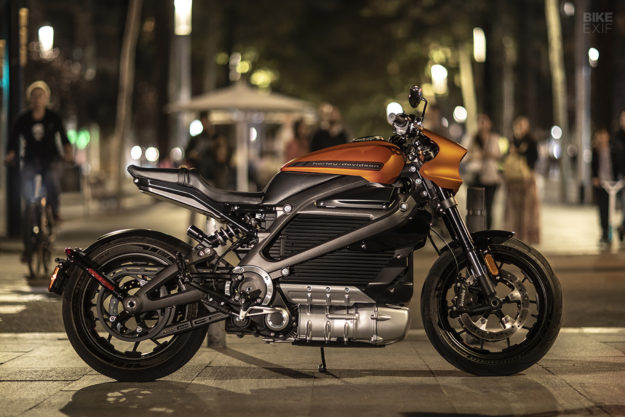
When I said Livewire wasn’t designed for millennials…the experience was. But that wasn’t necessarily our primary objective. Our primary objective was to do a very compelling motorcycle in general, with this new EV technology. And put it in the Harley-Davidson lineup, designed with Harley-Davidson DNA and ethos.
So was the motivation more about a solid product than massive sales?
Brad: There are a lot of people at Harley-Davidson that are much smarter than I am, and figure out business cases. We don’t set out to lose money on anything. But a product like this, there’s a different nuance to it, because it’s about the future. And it’s about trying to attract a new customer to the brand.
And frankly, there are a lot of places in the world where internal combustion will eventually go away. And so we want to have something for those folks. So that is the other piece that’s very important to think about.
Because again, going back to the beginning of the company, I argue to people that in 1903, Harley-Davidson was Apple. In 1903, most people didn’t go more than, like, 14 miles from the farm they grew up on. All of a sudden here comes this product that allows you to go 100 miles from home in a day. Your social network has just increased in a magnitude of a hundred.
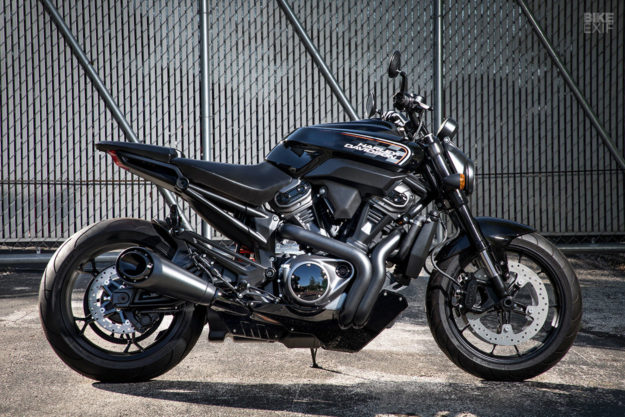
Changing gears back to gas and oil for a minute; when Pan America and Streetfighter [above] were announced, it was very subtly mentioned that the new motor would be coming in a 500 cc, 750 cc, 950 cc and 1250 cc versions. And I immediately thought, is this going to replace the Sportster?
Brad: We would never walk away from Sportster. Sportster is like Mustang. I had this conversation with a friend last night, the design director of Ford. We were talking about Sportster and talking about Ford. In the early 80s, they created the Ford Probe—remember that thing?
He said the Probe was the new Mustang. They felt the technology, and space age…this was gonna do it. And they researched it. And it just absolutely tanked. So at that point they decided, ‘you know what, let’s just keep Mustang around.’
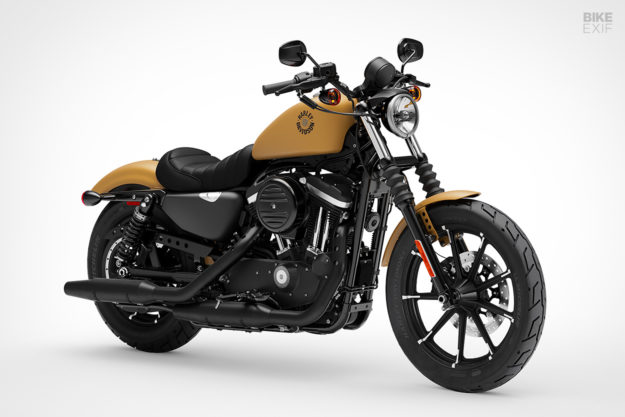
A lot of companies have extremely equitable iconic names in their brands, and sometimes, for whatever reason, they start to challenge whether those are still of value to the overall big picture and ecosystem. I think there were probably some conversations at Ford Motor Company that time, and somebody said ‘yeah we don’t see value in the Mustang name anymore, the new generation doesn’t care about that.’ And obviously they were proven wrong. Thank God, because that’s one of the best selling cars that Ford has.
So I love Sportster. I love internal combustion, Harley V-twins…that’s my passion. I can’t divulge future product stuff, but you know, the company would be in some kind of dire straits to walk away from the Sportster name and brand.
Pan America, Streetfighter and Custom [below] are pretty progressive, design wise. But take a bike like the Sportster Iron 883…is there room in that new platform for an updated Iron? How do you still develop bikes that appeal to core customers that want a ‘typical’ Harley?
Brad: One way to do it is to have an extremely modular platform. And so, again, there are certain iconic products in our lineup that we will continue to embrace. It’s very exciting designing Harley-Davidson motorcycles, because of all the passion that our customers have.
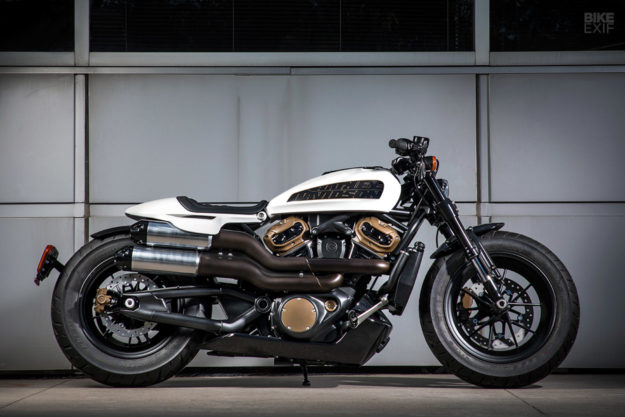
You evolve the product. And what we showed with those first three models, I think that shows the diversity that we’re really after. And showing what we can do when we really decide to move the needle in a way that’s going to attract a whole bunch of new incremental customers.
With those new models, are we looking at better performance, lighter bikes?
Brad: Have to. Because to your point about some of the metric competition, you can find bikes that are a lot less expensive than a Harley-Davidson, that have some of these performance attributes, that are more compelling. So we have to move the needle on everything. It’s gotta be lighter, it’s gotta be faster, it’s gotta be more of a visceral experience.
We can’t walk away from the connection that you have emotionally to a Harley-Davidson when you ride it. It’s not the same connection I have when I ride one of my Ducatis, or ride a friend’s Yamaha. They’re great bikes, but emotionally they’re the most un-compelling. They’re appliances to me.
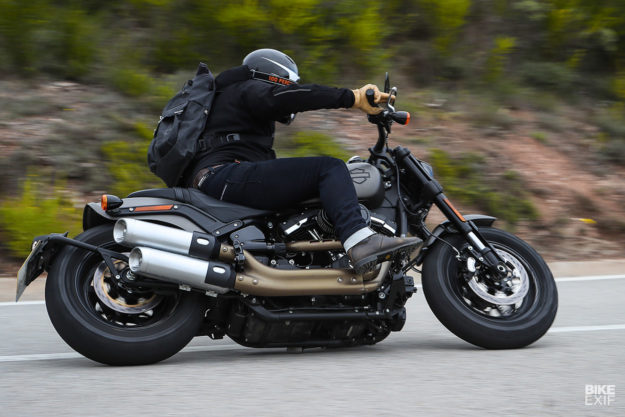
A Harley-Davidson is not a disposable product. It’s something you hand down to your son or daughter. We need to continue to do that, with even the electric product and all the technology that we’re embracing, the Harley DNA needs to come through. That is our special sauce, we cannot walk away from that.
A lot of people see you as a company that just makes cruisers—are you trying to break that perception, trying to get back to being perceived as a motorcycle company?
Brad: Yeah. I think that everything we’re doing is proving that’s our goal.
Our thanks to Brad, Joe and Harley-Davidson.
Harley-Davidson | Instagram | Images by Harley-Davidson and Wes Reyneke.